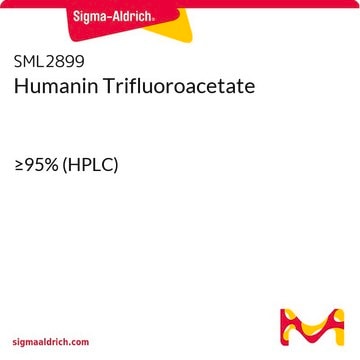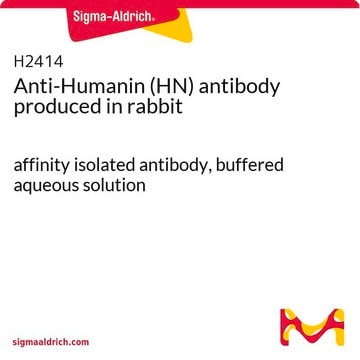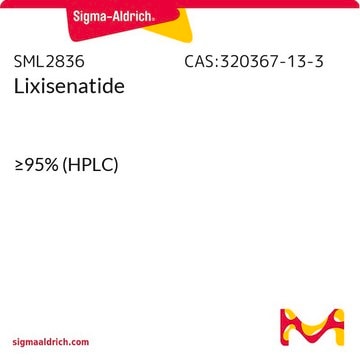H6161
[Gly14]-Humanin G human
≥95% (HPLC), powder
Sinonimo/i:
S14G-humanin, HNG
About This Item
Prodotti consigliati
Origine biologica
human
Livello qualitativo
Saggio
≥95% (HPLC)
Forma fisica
powder
PM
2654.2-2660.2 Da
Condizioni di stoccaggio
(Keep container tightly closed in a dry and well-ventilated place)
tecniche
activity assay: suitable
Solubilità
water: 1.00-1.04 mg/mL, clear, colorless
Condizioni di spedizione
dry ice
Temperatura di conservazione
−20°C
Amino Acid Sequence
Descrizione generale
[Gly14]-humanin (HNG) belongs to the family of mitochondrial-derived peptides. HNG (humanin-G) is an analog of humanin, generated by S14G (serine-14-glycine) mutation. HNG shows a 1000 times stronger activity.
Applicazioni
- along with bortezomib in pharmacological inhibition studies to treat mice to limit the toxic effects of bortezomib
- to study its effect on high glucose (HG)-induced apoptosis of endothelial cells (ECs)
- to study its neuroprotective effects in an in vitro oxygen-glucose deprivation/reoxygenation (OGD/R) model using SH-SY5Y neuroblastoma cells
Azioni biochim/fisiol
Anticorpo
Prodotti correlati
Codice della classe di stoccaggio
11 - Combustible Solids
Classe di pericolosità dell'acqua (WGK)
WGK 3
Punto d’infiammabilità (°F)
Not applicable
Punto d’infiammabilità (°C)
Not applicable
Dispositivi di protezione individuale
Eyeshields, Gloves, type N95 (US)
Certificati d'analisi (COA)
Cerca il Certificati d'analisi (COA) digitando il numero di lotto/batch corrispondente. I numeri di lotto o di batch sono stampati sull'etichetta dei prodotti dopo la parola ‘Lotto’ o ‘Batch’.
Possiedi già questo prodotto?
I documenti relativi ai prodotti acquistati recentemente sono disponibili nell’Archivio dei documenti.
Il team dei nostri ricercatori vanta grande esperienza in tutte le aree della ricerca quali Life Science, scienza dei materiali, sintesi chimica, cromatografia, discipline analitiche, ecc..
Contatta l'Assistenza Tecnica.




![[Nle4, D-Phe7]-α-Melanocyte Stimulating Hormone trifluoroacetate salt ≥95% (HPLC)](/deepweb/assets/sigmaaldrich/product/structures/276/187/9733edf4-6412-4f2b-8cc6-c3f9f3425d4d/640/9733edf4-6412-4f2b-8cc6-c3f9f3425d4d.png)



